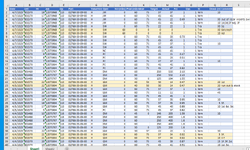Option Explicit
'to force variable declaration use Option Explicit as the first line in your module
'This decreases bugs, as mistyped variables are flagged up
Sub CombineDupicates()
Dim vIn As Variant, vOut As Variant
Dim lRi1 As Long, lRi2 As Long, lC As Long, _
UB1 As Long, UB2 As Long, lRo As Long, UB2Last As Long
Dim bIdentical As Boolean
'load the complete table into an array vIn. vIn then becomes like a fast sheet in memory
vIn = Range("A1").CurrentRegion
'get the nummber of rows ov vIn
UB1 = UBound(vIn, 1)
'and nr of columns
UB2Last = UBound(vIn, 2)
UB2 = UB2Last - 2 ' no need to check the last two columns
'Make vOut the same size as vIn
ReDim vOut(1 To UB1, 1 To UB2Last)
'copy the header row
For lC = 1 To UB2Last
vOut(1, lC) = vIn(1, lC)
Next lC
'now loop through the rows of the table, checking each line with the line below
'if different, then copy line to vOut
'if the same then copy line and combine info in the last two 'cells'
lRo = 2
For lRi1 = 2 To UB1 - 1
lRi2 = lRi1 + 1
bIdentical = True
For lC = 1 To UB2
If Not vIn(lRi1, lC) Like vIn(lRi2, lC) Then
'two lines are not the same, so stop checking
bIdentical = False
Exit For
End If
Next lC
If bIdentical Then
'two lines are identical
'copy the row to the next row in vOut
For lC = 1 To UB2
vOut(lRo, lC) = vIn(lRi1, lC)
Next lC
'then combine the last two cells
vOut(lRo, UB2 + 1) = vIn(lRi1, UB2 + 1) & ", " & vIn(lRi2, UB2 + 1)
vOut(lRo, UB2 + 2) = vIn(lRi1, UB2 + 2) & ", " & vIn(lRi2, UB2 + 2)
'increment the line for the output array
lRo = lRo + 1
'The 2nd line does not need to be tested again, so increment lRi1 to skip that line in the next loop
lRi1 = lRi1 + 1
Else
'the line below is not identical, so write current line to output array
For lC = 1 To UB2Last
vOut(lRo, lC) = vIn(lRi1, lC)
Next lC
'increment the line for the output array
lRo = lRo + 1
End If
Next lRi1
'Check the last line, as in the loop above lRi1 does not reach the lat line!
If lRi1 = UB1 Then
'the last line was not duplicate, so copy
For lC = 1 To UB2Last
vOut(lRo, lC) = vIn(lRi1, lC)
Next lC
End If
'Now write the output array to a new sheet.
'If you want to overwrite the original table, then set the flag bNewSh to false
Dim bNewSh As Boolean
bNewSh = True 'output to new sheet
If bNewSh Then
ThisWorkbook.Sheets.Add
ActiveSheet.Name = "CleanedUpTbl"
End If
Range("A1").Resize(UB1, UB2Last).Value = vOut
End Sub







